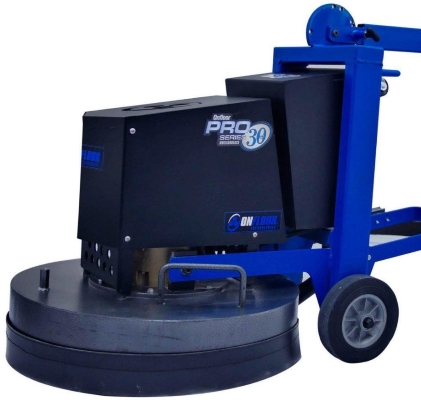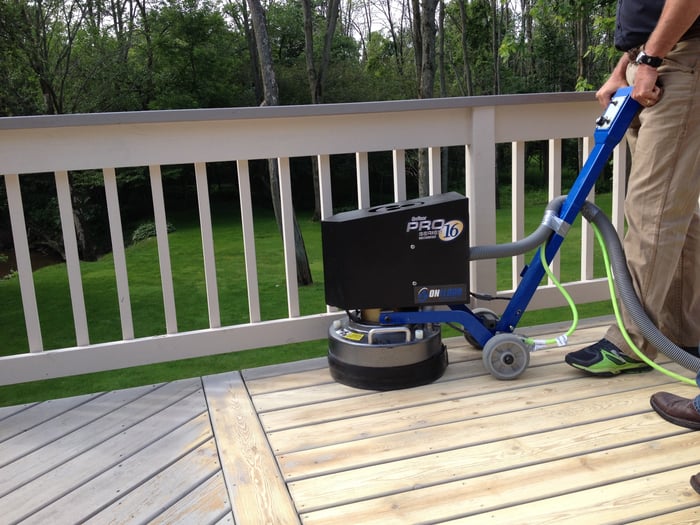Updated May 31, 2023
What happens when you encounter floors with uneven surfaces? Or you want to put new flooring in that apartment? Grinding is a necessary floor preparation process, and you can do that with floor grinding machines.
Those fancy epoxy coatings you want to place on your garage floor are best applied after grinding the garage floor. Using floor grinders helps you clean, smooth, polish, and level the surface, ready for further treatment. It doesn’t matter whether you have hardwood, stone, or concrete floors.
Floor grinders are not limited to commercial buildings or industrial complexes; you can use them in residential buildings too. We will explain what these grinding machines are used for, including their operation. You’ll also learn about the types available, the floors you can use them on, and tips for buying or hiring one.

What Are Floor Grinders Used For?
Construction projects and facility maintenance are things that we can’t do without. The facility maintenance industry is worth $42 billion and growing. We know the processes there can range from smaller jobs like fixing a window in a residential building to installing an HVAC system in commercial buildings.
One essential part of construction projects or facility maintenance is flooring. It could be installing new floors or preparing an existing one for coating.
With that in mind, here are the typical uses of floor grinding machines:
- They are used for grinding and polishing concrete floors (concrete grinding machines).
- They are used for grinding and polishing hardwood and stone floors.
- They are used for surface preparation.
- You can use floor grinders for stain and coating removal.
- They are used to smooth tile grout lines.
- They are used to level an uneven surface.
These use cases show how much we need floor grinding machines for personal or commercial projects. They are indispensable for creating the ideal flooring for the building.
The benefits are more significant when you perform grinding jobs on large surfaces. That’s when you’ll be glad to have a high performance grinding machine on your side. You can also increase productivity with a remote controlled grinder.
Working Principle of a Floor Grinder
So, what is the working process of these types of grinders? How do they achieve smooth, clean, and polished floors?
The DIY grinder and the one professional users use for industrial applications share the same working application. They differ in build and accessories. Nonetheless, it’s best to know the components before explaining how they combine to achieve the grinding and polishing processes.
Components of a Floor Grinder
Let’s examine the components of a typical grinding machine, like the OF9S-l-grinder-polisher. You’ll often find the following parts:
- Bond: This part supports the diamond and is subject to wear. However, it wears off in a way that does not cause diamond breakage.
- Diamond: This part grinds the wooden or concrete surface and comes with different-sized grits. You can identify the ideal diamond for a project based on its size and grit number. However, both parameters are inversely proportional.
The grinding discs carry the diamond and are responsible for the grinding width. The wider the grinding discs, the more ground you can cover, whether for concrete surface preparation or polishing. For example, the OFS30 planetary grinder has a 30-inch cutting path for wider coverage.
Other parts of these grinders include the following:
- Electric motor: responsible for the rotary motion of the discs and can come with a fixed or variable speed.
- Back wheel: supports movement during usage or transport.
- Inverter: provides power to the onboard battery. You’ll need it if you don’t want to run the grinder off an external power supply.
- Vacuum hose: removes dust as you grind the surface.
- Water tank: holds the water for lubrication while the grinder is used.
How It Works
You will appreciate the operating principle better after knowing the components of a typical grinder. Here’s how the floor grinder carries out the process, whether to polish, smooth, or remove stains.
The electric motor receives power from the inverter, battery, or mains. It transmits the power through a rotational motion to the discs carrying the diamond or pad. Weights may be placed on the disc section to press it more against the wooden or concrete surfaces.
The operator moves the grinder in a smooth and even fashion along the concrete surfaces until an even surface is achieved. This motion can continue until the stains are removed if the goal is stain removal.
The placement of weights can be used to control precision. Most professionals begin with more abrasive diamond tools and work down to the finer discs.
Also, you can have several discs to increase the grinding width instead of having one large disc. That is more efficient during operation and replacement.
Some floor grinders use a vacuum hose to remove the dust. Others use water control and dust skirts to control dust during the operation. Whatever is present, dust removal is essential to prevent health hazards while used.

Types of Floor Grinders
There are various types of floor grinding machines, and they come at different prices and power levels. Those with more power suit commercial settings, especially indoor car packs.
With that in mind, here are the various types you will find:
- Ride-on-floor machines: These machines have the most power. However, they are also the most expensive. You can use them on flooring for large commercial and industrial projects like shopping centers.
- Walk-behind concrete floor grinders: This equipment is ideal for concrete surfaces that prove difficult for handheld models. It is large, powerful, and has rollers to move them around.
- Handheld grinders: These machines are lightweight and easy to hold. You won’t find a powerful planetary grinder in this category, as they are often low-powered. In addition, they are not efficient for a precision job.
Floors That Require a Floor Grinder
You can’t use a grinder on virtually any surface. For example, the grinder and accessories you will use for natural stone like marble will differ from those for wood. Here are the floors you can use a grinder on:
- Hardwood: Wood is the easiest to grind, and you don’t need many tools for the job, except that it is a large area. You can use the floor grinding equipment for refinishing or restoration, like on wooden decking.
As a homeowner interested in DIY, you can rent the machine to work on your wooden floors. It is undoubtedly the better choice to cover a large area quickly.
- Stone: A natural stone like marble brings beauty to residential and commercial buildings. The fire resistance is an added advantage. However, they lose their shine over time.
Floor grinding is done to level the surfaces, polish them, and restore their shine.
- Concrete: Concrete is a low-cost option for the $477 billion warehouse industry. It is inexpensive but susceptible to cracks and uneven surfaces. Hence, you’ll need high-powered floor grinding equipment to get it back in shape.
It is essential to grind the concrete, whether you want a better finish or to prepare it for further finishing.
Tips for Picking and Working with Floor Grinders
It is best to hire a contractor if you have a flooring project. However, you can consider the following when picking grinders for a DIY project:
Choose Power
The details of the project ultimately determine how much power you need. Using an underpowered machine on a hard surface might damage the machine.
Find Out the Nature of the Surface
You should have full access to the area if hired for a grinding job. Assess whether you have a wet or dry place. Some grinders work best in dry conditions, while others are designed for wet conditions.
Dust Disposal
Dust will come off whether you are grinding or polishing concrete or other floor types. On that account, you must pick a grinder with an in-built vacuum system or one that can be connected to an external vacuum system.
Pick the Right Diamond Grit
The floor type determines the diamond tools you’ll need. Ensure you pick the appropriate grit size for the material. For example, the tools you’ll need for wood will differ from the ones for concrete.
Choose the Right Grinding Width
You don’t want a small width when you have a large area. The larger the site, the larger the width of the equipment you should use.
Operational Reliability
Don’t use tools that will fail on the job. Ensure you use reliable accessories and don’t compromise your choice of wood, natural stone, or concrete.
Pressure
The pressure is proportional to how much material is removed. A grinder with higher pressure can remove more material. However, it needs special attention on uneven surfaces.
Conclusion
Flooring wears out and loses its sparkle over time, whether wood, stone, or concrete. Knowing when to redo your flooring is as essential as picking the right equipment.
A floor grinder cleans, smooths, and polishes floors. Hence, you can use them for leveling, refinishing, or restoration.
This equipment ranges from simple handheld variants to high-powered, heavy-duty, and even remote controlled variants. You can use one at a time, but nothing stops you from having a unique combination for a specific job.
Contact OnFloor to get started on selecting the best fit for your next home or industrial project.
1 Comment